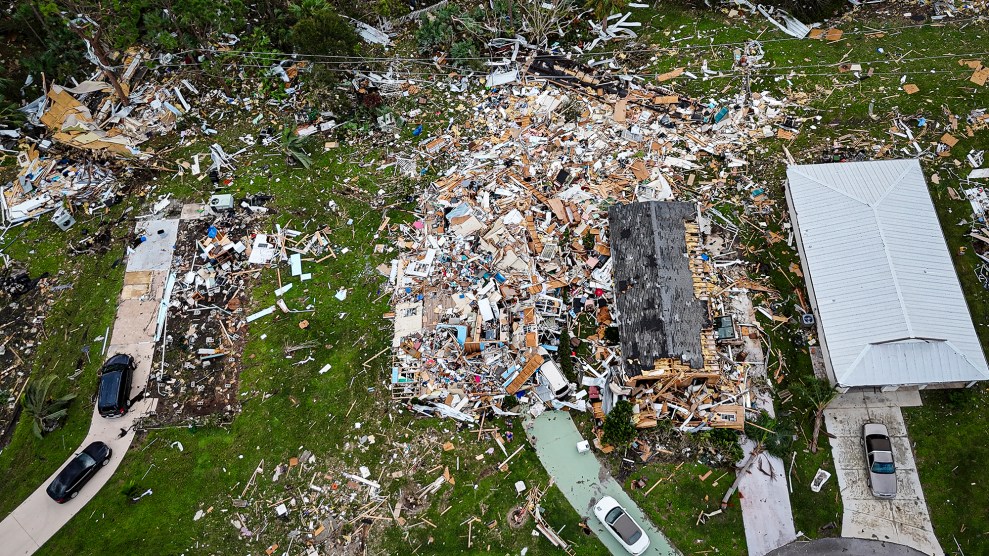Panoramic photo of rolling Arctic meadows… Close-up of tundra wildflower… Medium shot of (whoa!) bloody carcass ravaged by wolves…
“It’s a tough life being a caribou,” Ken Madsen tells about 100 environmentalists clustered in a dark auditorium at the Canadian Embassy in Washington, D.C. Madsen, a writer and photographer, is narrating a rally- the-ecotroops slide show about the Arctic National Wildlife Refuge, the 20-million-acre preserve sometimes dubbed “America’s Serengeti.” Life could get even tougher for ANWR’s 130,000 caribou if the Bush administration succeeds in its current push for oil drilling inside the 1.5-million-acre coastal heart of the refuge, precisely where the caribou come to birth calves each summer. Biologists who have studied the area warn that noise, pollution, and road construction could drive the caribou away from the calving grounds, weakening the herd and changing its age-old migration pattern. And that could be bad news for the Gwich’in Nation, a confederation of some 8,000 indigenous people hunkered down in 15 villages along the U.S.-Canadian border.
After Madsen’s slide show, 18-year-old Justin Gemmill takes to the microphone. For 20,000 years, he explains, the Gwich’in calendar has revolved around the migration that takes the caribou herd past their villages on its way from the coast to the Yukon highlands. The Gwich’in fashion clothing and tools from caribou. They eat caribou as often as three times a day. Caribou is to them what, well, oil is to most Americans. Imagine, Gemmill says, caribou songs and dances robbed of meaning, Gwich’in children raised on mere memories of caribou hunts. “It’s just like being told what heaven is like,” he murmurs, “and not being allowed to go there.”
The Gwich’in’s stake in the ANWR battle is so high, it has compelled them to abandon their traditional reluctance to get involved in the politics of the outside world. Every few years since Congress first considered opening ANWR for drilling in 1988, they have sent emissaries to lobby politicians in Washington and Ottawa. They have joined forces with environmental groups including the Natural Resources Defense Council, the Sierra Club, and the Wilderness Society. A committee of eight tribal elders directs the lobbying campaign, hosts press trips, and maintains a Web site.
Oil industry representatives say the Gwich’ins’ fears are unfounded. Recent technological advances have reduced the “footprint” oil operations leave upon the land, they note; in addition, caribou herds on Alaska’s North Slope have actually increased in number since drilling began in Prudhoe Bay 30 years ago. But Fran Mauer, an ANWR staff biologist for 20 years, warns against drawing general conclusions from that operation. Studies show that cows that spend more time near the oil fields weigh less and have fewer calves, and the Prudhoe herd’s main calving area has shifted more than 25 miles. In the refuge, Mauer says, females don’t have as much luxury of movement. “We have a narrow strip of coastal tundra, which ranges from 15 to 40 miles wide,” he explains. “But we have five to six times as many caribou.”
A 1995 report prepared by the Department of the Interior struck a similar tone, noting that the current calving grounds feature a perfect combination of soft, plentiful grass and protection from predators. “The cumulative effects of reduced access to [this] habitat would result in a major adverse impact on the herd,” it concluded.
Vice President Cheney, head of Bush’s energy policy task force, has said he wants to get a bill that allows drilling in the refuge through Congress this summer. Environmentalists are cautiously confident that the measure will fail, at least for now. That would leave the Gwich’in free to prepare for the fall hunt — and for another trip to Washington, the next time the proposal comes up. “In 1988, when the elders directed the people to take a political stand, it was like a prophecy,” says Faith Gemmill, coordinator for the Gwich’in steering committee and Justin’s older sister. “They said, ‘If you do this in a good way, we’re going to be successful.’ We’ve had very close calls, but we’ve always managed to defeat it.”
















